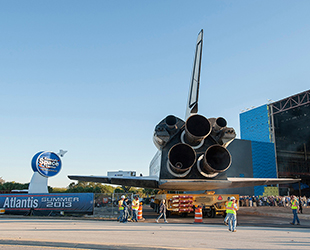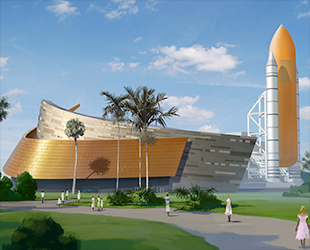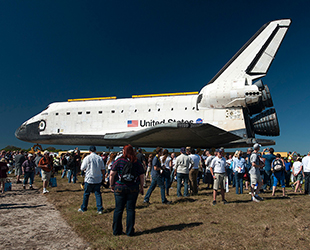November 3, 2012 — NASA's space shuttle Atlantis has again reached its "final stop," and this time, it's for good.
On Friday (Nov 2.), the space agency's last shuttle to fly in space became the last to be delivered to a museum as Atlantis arrived at NASA's Kennedy Space Center Visitor Complex to begin its new life as a dramatically-displayed centerpiece of a $100 million exhibit scheduled to open in July 2013.
The 9.8 mile (15.8 kilometers) trip, which began at dawn at Kennedy Space Center's 52-story tall Vehicle Assembly Building (VAB) and ended at dusk at the visitor complex's five-story exhibit building, signaled an end to the epilogue of NASA's 30-year space shuttle program, which came to its close last year.
"Now Atlantis will continue its life," said Chris Ferguson, who commanded Atlantis on its 33rd and final mission in July 2011, remarking then that its landing was the orbiter's — and the shuttle program's — "final stop."
"Its life of exploration is complete and it will go on in what I consider to be an incredibly fitting facility," he continued, addressing shuttle program workers on Friday. "Its life of education will pick up at this point forward."

Space shuttle Atlantis arrives at NASA's Kennedy Space Center Visitor Complex in Florida, Friday, Nov. 2, 2012, where it will go on display. [Gallery] (cS/Ben Cooper/LaunchPhotography.com) |
Atlantis completed its last move with NASA officials and thousands of visitor complex guests looking on. A parade of more than 30 former astronauts joined the orbiter for the final leg of the trip before it parked in front of the remaining open wall of the 90,000-square-foot exhibit building that has been under construction since January.
A fireworks display above and behind the shuttle heralded Atlantis' arrival, before the orbiter rolled into its new home.
Raising Atlantis
When Atlantis' still-be-named facility opens its doors to the public next summer, guests will have the opportunity to see the shuttle as only astronauts like Ferguson were able to do so. The orbiter will be exhibited as it looked when in Earth orbit, having just departed the International Space Station (ISS), with its payload bay doors open and its Canadarm robotic arm deployed.
"We think visitors to [the] visitor complex will be awed and inspired by how they will see and experience Atlantis," Bill Moore, chief operating officer of the complex, said.

Artist's rendering of space shuttle Atlantis on display at NASA's Kennedy Space Center Visitor Complex in Florida. (KSCVC) |
To achieve the appearance of flying in space, Atlantis will be raised 36 feet into the air and rotated 43.21 degrees to one side. The complex operation, which will employ steel beams and jacks from below the space shuttle rather than cranes from above, is slated to be finished by the middle of November.
Concurrently, work will also get underway to seal Atlantis inside, as crews work to erect the building's fourth wall by mid-December.
To protect Atlantis from dust and debris as its building is completed around it, it will be shrink-wrapped in plastic as part of the process of raising it off the ground. The wrap will be removed next spring, to allow the work needed to open Atlantis' two 60-foot (18 meters) payload bay doors and to install the replica robotic arm.
Atlantis' display will also include numerous related exhibits to educate visitors about the shuttle's achievements.
"Complementing Atlantis will be more than 60 interactive, immersive exhibits about the entire space shuttle program including its key role with the International Space Station and the Hubble Telescope, and how it paved the way for today's new space programs," said Moore.
Even the building's exterior has been designed to immerse visitors in the shuttle's story.
Featuring two sweeping architectural elements, or "wings" representing the shuttle's launch to and return from space, the outer layer of the building, which is being cloaked in iridescent hues of orange and gold, evokes the fiery-glow of re-entry. The taller, internal wing of the building is being covered in a shimmering tile pattern in varying gray tones designed to mimic the tiled underside of the orbiter.

Artist concept of the $100 million Atlantis exhibit building at the Kennedy Space Center Visitor Complex in Florida. (KSCVC) |
At the entrance to the exhibit, guests will be greeted by a full-size, upright, replica external tank and two solid rocket boosters, expected to be installed in the coming months. On the opposite side of the tank and booster assembly, a silhouette of the orbiter will be attached to show guests its exact size and placement.
The 184-foot-tall shuttle stack will give visitors a sense of the massive size and power used to thrust the shuttle into low-earth orbit, before they get up close to the real thing — Atlantis.
Sneak-a-Peek
Beginning Saturday (Nov. 3) and continuing through Nov. 11, visitors to the Kennedy Space Center Visitor Complex will have a limited opportunity to "Sneak-a-Peek" and see Atlantis inside its new home before it is sealed inside.

The public gets an up-close look at space shuttle Atlantis during its delivery to NASA's Kennedy Space Center Visitor Complex. [Photo Gallery] (cS/Ben Cooper/LaunchPhotography.com) |
Construction of the building will pause on weekends and weekday afternoons to enable guests to have an up-close look at Atlantis. Tour guides will escort the public through the construction zone, provide details about the orbiter's new exhibit, and allow visitors to take photos and pose in the secured area.
"We are excited to offer this rare opportunity for Kennedy Space Center Visitor Complex patrons," said Moore in a statement. "We know they'll cherish seeing Atlantis in this unique setting before construction is completed and the exhibit is unveiled to the world next July."
The "Sneak-a-Peek" tour of Atlantis in its new building will be offered:
Nov. 3 to 4: 9 a.m. to 6 p.m. EDT
Nov. 5 to 9: 2 p.m. to 5 p.m. EDT
Nov. 10 to 11: 9 a.m. to 5.p.m. EDT
See shuttles.collectspace.com for continuing coverage of the delivery and display of NASA's retired space shuttles.
